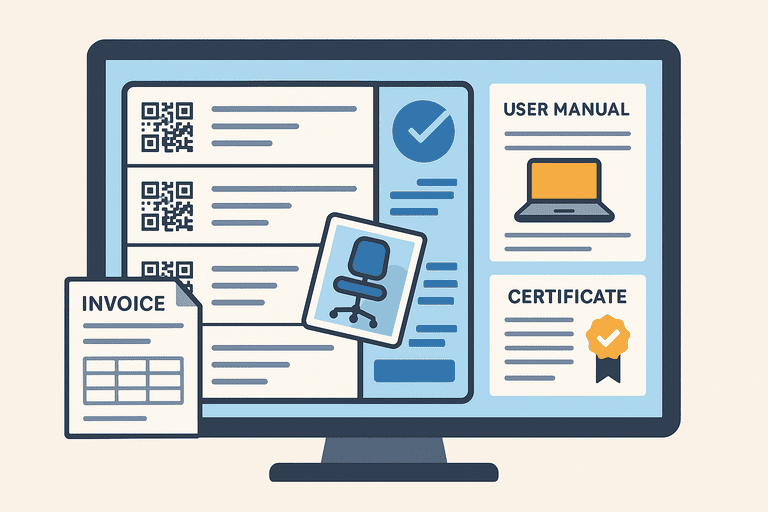Imaging & Document Attachments in Asset Records
Learn how attaching photos, invoices, manuals, and compliance certificates to asset records enhances traceability, accountability, and audit readiness.

Introduction
A picture may be worth a thousand words — but in asset management, it can also be worth thousands of dollars saved.
Attaching visuals and documents to your asset records helps organizations move from generic data to complete, contextual records.
This article explores how to implement document and image attachments effectively, what file types matter most, and how this practice supports audits, insurance claims, and daily operations.
1. Why Attach Documents and Images to Asset Records?
Modern inventory management isn’t just about knowing what you own — it’s about proving it.
Benefits include:
- Visual verification: Confirms the condition and identity of assets.
- Faster audits: Auditors can verify assets remotely with visual evidence.
- Insurance claims: Photos and receipts simplify damage or loss documentation.
- Maintenance traceability: Attach manuals, calibration logs, and service reports.
- Compliance: Store certificates and inspection results for regulated equipment.
By linking supporting documents to each item, you eliminate guesswork and strengthen accountability.
2. Types of Attachments to Maintain
| Category | Example Documents | Value |
|---|---|---|
| Proof of Purchase | Invoices, receipts | Verifies ownership, cost, and depreciation value |
| Maintenance Logs | Service reports, calibration certificates | Ensures traceability and compliance |
| Warranty Information | Warranty cards, coverage details | Helps claim replacements or repairs |
| User Manuals | Setup guides, quick-start PDFs | Supports new staff or remote teams |
| Photographic Evidence | Photos of condition, serial numbers, location | Simplifies audits and theft recovery |
Having all these files stored centrally turns your inventory into a searchable, compliant database.
3. Best Practices for Asset Imaging
Images should serve as clear, verifiable evidence — not just decoration.
Follow these principles to ensure your attachments add value:
- Capture multiple angles — front, side, and serial number views.
- Include environment context — show the asset in its real location.
- Use consistent resolution — typically 800–1200 px wide for clarity.
- Name files logically — e.g.,
Laptop_HP_Elitebook_SN12345.jpg. - Compress without losing detail — to save storage space.
Pro tip: Photograph assets right after tagging them with QR codes or asset labels for a reliable reference.
4. Managing File Formats and Metadata
When attaching files, it’s crucial to define standards for:
- Accepted file types:
.jpg,.png,.pdf,.docx,.csv. - File size limits: Prevent system overload or slow uploads.
- Metadata structure: Include fields like upload date, uploader name, and file purpose.
This structure ensures files remain searchable and usable across your organization.
5. Security and Access Controls
Sensitive files (like invoices or certifications) require controlled access.
Follow these security guidelines:
- Use role-based permissions to define who can upload or view attachments.
- Enable version tracking for documents that may change over time.
- Encrypt files in transit and at rest.
- Log every upload or download for audit trails.
By balancing convenience with security, you protect both your operational integrity and your data privacy.
6. Integrating Attachments into Workflows
Well-integrated document management supports every operational phase:
| Workflow Stage | Document Type | Benefit |
|---|---|---|
| Acquisition | Invoice, purchase order | Verifies source and cost |
| Operation | User manual, warranty card | Simplifies support |
| Maintenance | Inspection report, calibration data | Improves reliability |
| Disposal | Disposal form, transfer record | Confirms compliance and traceability |
This continuity strengthens compliance with ISO, ITAM, and financial audit standards.
7. Common Mistakes to Avoid
- Unlabeled uploads — impossible to search later.
- Duplicated files — wastes storage and confuses teams.
- No version control — outdated documents cause compliance risk.
- Private file sharing — bypasses centralized record keeping.
- Inconsistent file formats — breaks integrations and exports.
Establishing a single workflow for uploading and tagging attachments prevents these pitfalls.
8. Future Trends: Smart Imaging and AI Classification
AI is increasingly used to auto-tag and classify attachments.
Emerging features include:
- Automatic recognition of invoices, serial numbers, or barcodes.
- Image-based condition analysis (detecting wear or damage).
- Document OCR (Optical Character Recognition) for search indexing.
These tools streamline record-keeping and enhance accuracy — especially for large organizations with thousands of assets.
Conclusion
Attaching documents and images to asset records isn’t just good housekeeping — it’s a cornerstone of modern, auditable asset management.
From insurance claims to maintenance logs, every visual and document adds clarity, compliance, and accountability.
By adopting a structured attachment policy, businesses ensure that every asset tells a complete, traceable story.
Explore related topics: